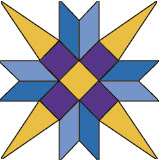PSQG Quilt Show Definitions and Clarifications
Revised February 9, 2024
General definitions and clarifications:
Display quilts:
Every member of our guild is invited to enter a display quilt. These quilts will not be judged, but will be eligible for our viewer’s choice ribbon. You must be a member of the guild to display a quilt(s).
Quilt:
A quilt is defined as having three layers: top, batting, and backing, held together by stitching, which is distributed throughout the work. If this is a judged quilt, the judge must be able to see the work on the back; no false backs or frames. If you are interested in creating a judged quilt, you may want to read the judge’s criteria.
Perimeter:
Used to determine the size category, the perimeter is the sum of all four sides of a quilt. (Width plus width plus length plus length equals perimeter.) This is the same as (width inches + length inches) x 2 = perimeter inches.
Sleeve:
A 4” sleeve, or rod pocket, is required for every entry. Position the sleeve so your quilt does not touch the floor when hung. Our rods at the show allow you about 90” from the top of your quilt to the floor. Please sew the sleeve to the quilt back. Straight pins are never an option. Instructions for making and attaching the sleeve can be found on the PSQG website.
Other items to note:
All quilts should be clean. Clean quilts have no pet hair or strong odors (like cigarette smoke or musty basement). Odd-shaped or multi-paneled quilts should be mounted on black fabric with the sleeve sewn to the black fabric for hanging.
Width of black fabric should not exceed 90”.
Eligibility:
You must be a PSQG member in good standing (dues paid in full) to participate in the PSQG quilt show.
Judged quilt definitions and clarifications:
These are in addition to the general definitions and clarifications. There is a $10 fee for each Judged entry and you must be a PSQG member in good standing.
Quilts for judging should not have been judged at any previous PSQG show. Quilts for judging must not be a ribbon winner from any other quilt show.
Judging Categories:
PSQG reserves the right to shift categories or combine categories for judging purposes.
Art Quilt:
Art quilts must be your original design. The artist has something to say and has chosen the medium of a quilt to say it. Art quilts are made of fabric and have three layers (top, batting, back) held together by quilting stitches. A quilt based on someone else’s pattern, or a traditional pattern, or block designs should be entered in a different category. Art quilts are often decorative.
Modern Quilt:
Modern quilts include, but are not limited to: “The use of bold colors and prints, high contrast and graphic areas of solid color, improvisational piecing, minimalism, expansive negative space, and alternate grid work,” says The Modern Quilt Guild. Modern quilts are often functional.
Traditional Quilts:
Traditional quilts showcase excellence in construction and functionality.
Most quilts will fall into one of these categories.
- Mixed quilts use applique and/or other techniques along with piecing (can be foundation piecing, hand piecing, english paper piecing, or traditional).
- Pieced quilts have no other techniques on them.
- Whole cloth quilts are made of a single piece of fabric with quilting creating the design.
Quilting methods:
All methods are acceptable at our show, but here are some definitions.
- A stationary sewing machine sits on or is attached to a table and stays still while the fabric is being moved under the needle. Sometimes called quilting “on your domestic”, although some longarm machines quilt this way.
- A movable quilting machine is mounted on a frame where the machine moves over the stationary fabric. Typically, this is longarm quilting.
- Hand quilting is done with needle and thread. No machine work.
- Stitch regulated machines keep the stitching all the same length.
- Computer assisted quilting lets the machine do the work once it is programmed into the computer.
- Embroidery machine quilting runs the computer program to create a design that is generally confined to a small area.
